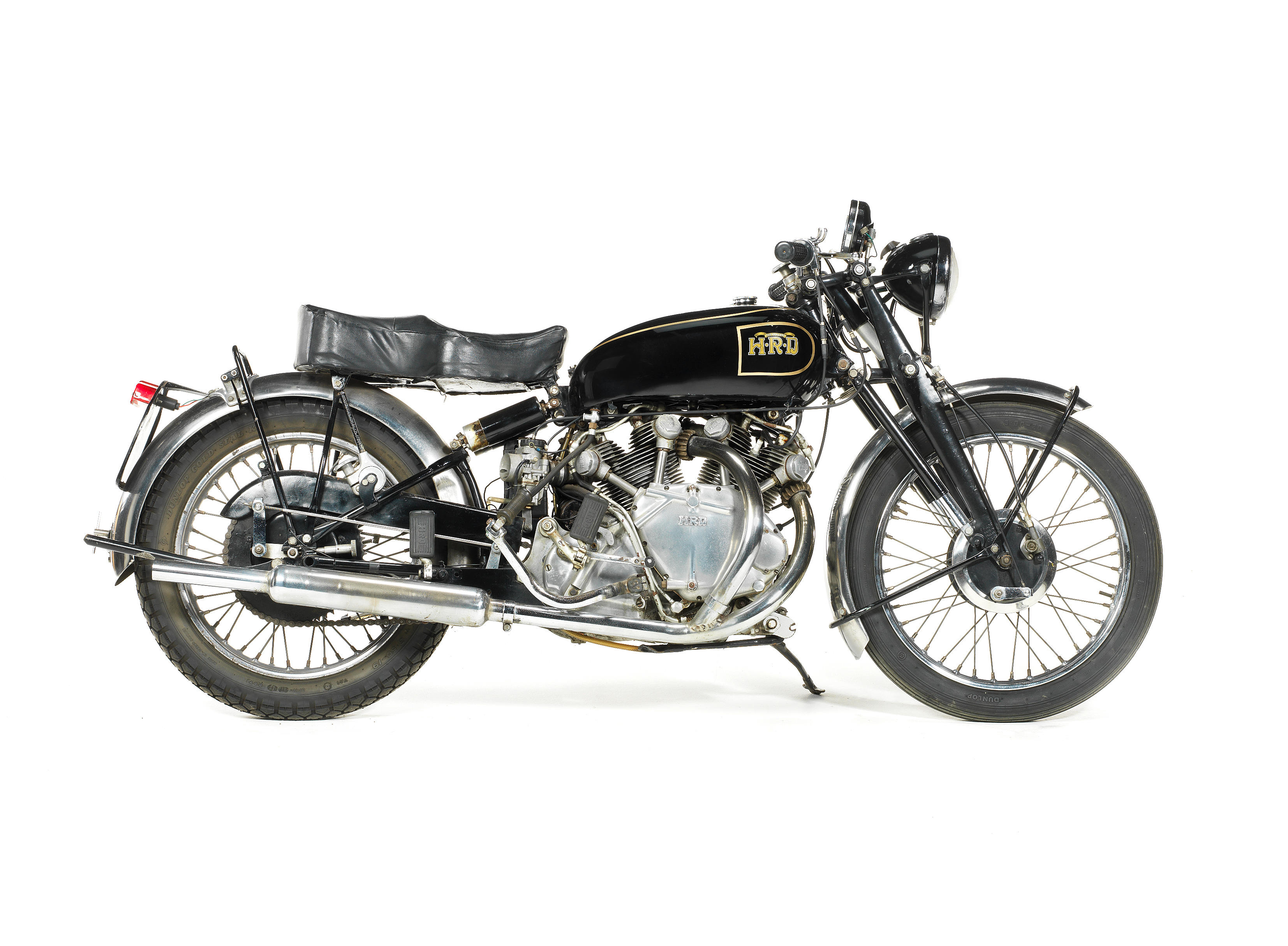Rear Frame no. RC/1/11563/B The outbreak of WW2 in 1939 brought production of all Series A models to a halt, and when Vincent resumed production at the war's end it was with the all-new Series B. Its rear suspension aside, the Series A Vincent-HRD had been conventional enough: tubular steel frame, girder forks, separate gearbox, etc but with the Series B Messrs Vincent and Irving effectively established the marque's reputation for the defiance of convention in the pursuit of engineering excellence. For a start there was no 'frame' as such, merely a fabricated box attached to the cylinder heads, that served as the oil tank and incorporated the headstock and the attachment point for the rear springs. The gearbox was integral with the engine, and the swinging arm pivoted directly in the engine/gearbox casings, features commonplace today but unusual 60 years ago. Only in his retention of the pre-war Brampton girder fork did Phillip Vincent appear to be lagging behind other manufacturers, almost all of which had switched to telescopics, but this apparent shortcoming would soon be addressed by the introduction of the famous 'Girdraulic' fork. Introduced in 1946, the Vincent-HRD Series-B Rapide was immediately the fastest production motorcycle on sale anywhere, with a top speed of over 110mph. The basic design clearly had even greater potential though, which would be realised later in the form of the Black Shadow and Black Lightning models. In 1948 the Vincent range began to be up-dated to 'Series C' specification. The most significant changes made concerned the suspension, there being a revised arrangement at the rear incorporating curved lugs for the seat stays and an hydraulic damper between the spring boxes, while at the front the new models boasted Vincent's own 'Girdraulic' fork: a blade-type girder fitted with twin hydraulic dampers. These advances began to find their way onto production models during 1948 but it would be 1950 before all Vincents left the factory in Series C specification. This Rapide was purchased from Mr David Crouch by His Grace the Duke of Hamilton in December 1980, joining his small private collection of classic motorcycles. Restored in 1981, it features a Smiths 150mph 'Shadow' speedometer and Amal Mk2 Concentric carburettors. Recent work has included cleaning the spark plugs and replacing the points. The machine is offered with sundry invoices, expired MoT (1981), a quantity of instruction sheets, BMS workshop manual, Harper Engines spares list, copy old-style Swansea V5 and current Swansea V5C documents. It should be noted that the engine has been re-stamped with the original's number and that the original engine exists in another machine.
Rear Frame no. RC/1/11563/B The outbreak of WW2 in 1939 brought production of all Series A models to a halt, and when Vincent resumed production at the war's end it was with the all-new Series B. Its rear suspension aside, the Series A Vincent-HRD had been conventional enough: tubular steel frame, girder forks, separate gearbox, etc but with the Series B Messrs Vincent and Irving effectively established the marque's reputation for the defiance of convention in the pursuit of engineering excellence. For a start there was no 'frame' as such, merely a fabricated box attached to the cylinder heads, that served as the oil tank and incorporated the headstock and the attachment point for the rear springs. The gearbox was integral with the engine, and the swinging arm pivoted directly in the engine/gearbox casings, features commonplace today but unusual 60 years ago. Only in his retention of the pre-war Brampton girder fork did Phillip Vincent appear to be lagging behind other manufacturers, almost all of which had switched to telescopics, but this apparent shortcoming would soon be addressed by the introduction of the famous 'Girdraulic' fork. Introduced in 1946, the Vincent-HRD Series-B Rapide was immediately the fastest production motorcycle on sale anywhere, with a top speed of over 110mph. The basic design clearly had even greater potential though, which would be realised later in the form of the Black Shadow and Black Lightning models. In 1948 the Vincent range began to be up-dated to 'Series C' specification. The most significant changes made concerned the suspension, there being a revised arrangement at the rear incorporating curved lugs for the seat stays and an hydraulic damper between the spring boxes, while at the front the new models boasted Vincent's own 'Girdraulic' fork: a blade-type girder fitted with twin hydraulic dampers. These advances began to find their way onto production models during 1948 but it would be 1950 before all Vincents left the factory in Series C specification. This Rapide was purchased from Mr David Crouch by His Grace the Duke of Hamilton in December 1980, joining his small private collection of classic motorcycles. Restored in 1981, it features a Smiths 150mph 'Shadow' speedometer and Amal Mk2 Concentric carburettors. Recent work has included cleaning the spark plugs and replacing the points. The machine is offered with sundry invoices, expired MoT (1981), a quantity of instruction sheets, BMS workshop manual, Harper Engines spares list, copy old-style Swansea V5 and current Swansea V5C documents. It should be noted that the engine has been re-stamped with the original's number and that the original engine exists in another machine.















Testen Sie LotSearch und seine Premium-Features 7 Tage - ohne Kosten!
Lassen Sie sich automatisch über neue Objekte in kommenden Auktionen benachrichtigen.
Suchauftrag anlegen